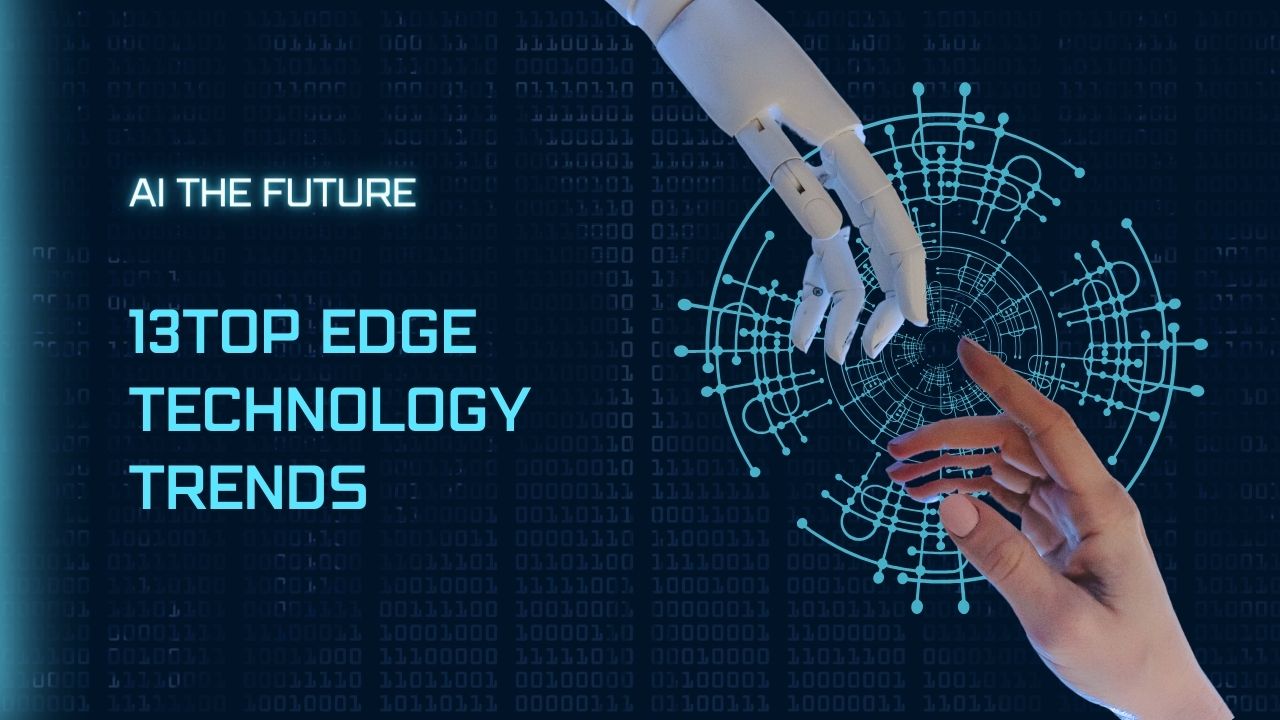Technology is evolving at a rapid pace, enabling faster change and progress in various domains. However, not all technology trends are equally impactful or relevant for different sectors and regions. To stay ahead of the curve and gain a competitive edge, it is important to know which technology trends will shape the future and how they can be leveraged for innovation and growth.
In this article, we will explore 13 top technology trends that are expected to dominate the next two years (2023 & 2024) and how they can benefit various industries and markets, especially in India. We will also identify the content gaps in the current top-ranked articles on the keyword “trending technology” and cover all the aspects that need to be written about to outrank them.
1. Artificial Intelligence (AI) and Machine Learning (ML)
AI and ML are not new technologies, but they are becoming more advanced and pervasive in every domain. AI and ML enable machines to learn from data, perform complex tasks, and provide intelligent solutions. Some of the applications of AI and ML include:
- Natural language processing (NLP) for speech recognition, text analysis, chatbots, etc.
- Computer vision for face recognition, object detection, medical imaging, etc.
- Data analytics for business intelligence, customer insights, fraud detection, etc.
- Robotics for automation, manufacturing, logistics, etc.
- Recommendation systems for e-commerce, entertainment, education, etc.
AI and ML are also driving the development of other technologies such as extended reality (XR), edge computing, quantum computing, etc. According to a report by PwC India, AI could add up to $957 billion to India’s GDP by 2035, making it one of the biggest economic opportunities for the country.
2. 5G and Internet of Things (IoT)
5G is the next generation of wireless communication technology that promises faster speed, lower latency, higher bandwidth, and better connectivity. 5G will enable the proliferation of IoT devices that can interact and exchange data with each other and the cloud. IoT devices include smartphones, wearables, sensors, appliances, vehicles, etc. Some of the benefits of 5G and IoT include:
- It has enhanced user experience for online gaming, streaming, video conferencing, etc.
- Improved productivity and efficiency for remote work, education, healthcare, etc.
- Increased innovation and opportunities for smart cities, agriculture, transportation, etc.
- Reduced costs and energy consumption for network operations, data transmission, etc.
According to a report by Ericsson India, 5G subscriptions in India are expected to reach 350 million by 2026, accounting for 27% of all mobile subscriptions. IoT devices in India are projected to grow from 200 million in 2016 to 2.7 billion in 2020, according to a report by NASSCOM.
3. Blockchain and Digital Trust
Blockchain is a distributed ledger technology that enables secure and transparent transactions without intermediaries. Blockchain can be used for various purposes such as:
- Cryptocurrencies for digital payments, remittances, investments, etc.
- Smart contracts for automated execution of agreements
- Decentralized applications (DApps) for peer-to-peer services
- Digital identity for verification and authentication
- Supply chain management for traceability and accountability
Blockchain can also foster digital trust among users by ensuring data integrity, privacy, and security. According to a report by NITI Aayog, blockchain can potentially save up to $5 billion annually for the Indian economy by reducing transaction costs, frauds, errors, and delays. Blockchain can also enable social impact initiatives such as financial inclusion, healthcare delivery, land records, etc.
4. Extended Reality (XR)
XR is an umbrella term that encompasses virtual reality (VR), augmented reality (AR), mixed reality (MR), and other immersive technologies that create or enhance digital experiences. XR can be used for various applications such as:
- Entertainment for gaming, movies, concerts, etc.
- Education for interactive learning, simulations, training, etc.
- Healthcare for diagnosis, treatment, therapy, etc.
- Tourism for virtual tours, travel guides, etc.
- Marketing for product demos, branding, customer engagement, etc.
XR can also enhance social interaction, creativity, and empathy among users by providing immersive and realistic experiences. According to a report by IDC India, the XR market in India is expected to grow at a compound annual growth rate (CAGR) of 76% from 2019 to 2024, reaching $1.8 billion.
5. Edge Computing
Edge computing is a paradigm that shifts the processing of data from centralized servers to distributed devices that are closer to the source or the user. Edge computing can offer several advantages such as:
- Faster response time for real-time applications
- Lower bandwidth consumption for data transmission
- Higher scalability and reliability for network performance
- Better security and privacy for data protection
Edge computing can also enable the integration of AI and IoT devices, as well as the development of new applications such as autonomous vehicles, smart grids, drones, etc. According to a report by Gartner, by 2025, 75% of enterprise-generated data will be processed at the edge, up from 10% in 2018.
6. Quantum Computing
Quantum computing is a technology that uses the principles of quantum physics to perform computations that are beyond the capabilities of classical computers. Quantum computers can leverage quantum bits (qubits) that can exist in superposition and entanglement, allowing them to process multiple states simultaneously and exponentially. Quantum computing can be used for various purposes such as:
- Cryptography for encryption, decryption, and security
- Optimization for logistics, scheduling, routing, etc.
- Simulation for modelling, testing, and prediction
- Machine learning for data analysis, classification, and generation
Quantum computing can also solve complex and intractable problems that are currently unsolvable by classical computers. According to a report by IBM India, quantum computing can potentially create $850 billion to $1.35 trillion of value globally by 2030, and India can capture 2% to 4% of this value.
7. 3D Printing
3D printing is a technology that creates physical objects from digital models by depositing layers of material on top of each other. 3D printing can be used for various purposes such as:
- Manufacturing for prototyping, customization, and mass production
- Healthcare for implants, prosthetics, organs, etc.
- Construction for buildings, bridges, infrastructure, etc.
- Education for learning tools, projects, experiments, etc.
- Art and design for sculptures, jewellery, fashion, etc.
3D printing can also reduce waste, cost, and time, as well as enable innovation and creativity among users. According to a report by 6Wresearch, the 3D printing market in India is expected to grow at a CAGR of 20% from 2018 to 2024, reaching $79 million.
8. Genomics and Biotechnology
Genomics is the study of the structure, function, and evolution of genomes, which are the complete sets of DNA in living organisms. Biotechnology is the application of biological processes, organisms, or systems for industrial or other purposes. Genomics and biotechnology can be used for various purposes such as:
- Medicine for diagnosis, treatment, prevention, and cure of diseases
- Agriculture for crop improvement, pest control, biofuels, etc.
- Environment for conservation, restoration, bioremediation, etc.
- Industry for biomanufacturing, biocatalysis, biosensors, etc.
Genomics and biotechnology can also enhance human health, well-being, and longevity, as well as address global challenges such as food security, climate change, and biodiversity loss. According to a report by EY India, the biotechnology sector in India is expected to grow at a CAGR of 14.7% from 2019 to 2025, reaching $150 billion.
9. New Energy Solutions
New energy solutions refer to the development and deployment of alternative and renewable sources of energy that are cleaner, cheaper, and more efficient than fossil fuels. Some of the new energy solutions include:
- Solar power for harnessing the energy from sunlight
- Wind power for harnessing the energy from wind
- Hydrogen power for producing and storing energy from water
- Nuclear power for generating energy from nuclear fission or fusion
- Bioenergy for converting biomass into energy
New energy solutions can also reduce greenhouse gas emissions, mitigate climate change impacts, and improve energy security and access. According to a report by IBEF India, the renewable energy sector in India is expected to reach 450 GW by 2030, up from 94 GW in 2020.
10. Robotic Process Automation (RPA)
RPA is a technology that uses software robots or digital workers to automate repetitive, rule-based, and high-volume tasks that are usually performed by humans. RPA can be used for various purposes such as:
- Finance and accounting for invoice processing, reconciliation, reporting, etc.
- Human resources for payroll processing, recruitment, onboarding, etc.
- Customer service for chatbots, email responses, ticket handling, etc.
- Operations for data entry, validation, extraction, etc.
RPA can also improve productivity, accuracy, efficiency, and compliance among organizations while reducing costs and errors. According to a report by Zinnov India, RPA adoption in India is expected to grow at a CAGR of 57% from 2019 to 2024, reaching $1 billion.
11. Cloud Computing
Cloud computing is a technology that provides on-demand access to computing resources such as servers, storage, databases, networks, software, etc. over the internet. Cloud computing can be used for various purposes such as:
- Hosting and delivering applications and services
- Storing and managing data and information
- Analyzing and processing data and insights
- Developing and testing software and platforms
- Scaling and optimizing performance and resources
Cloud computing can also enable flexibility, agility, scalability, and reliability among organizations while reducing capital and operational expenses. According to a report by NASSCOM India, the cloud market in India is expected to grow at a CAGR of 30% from 2018 to 2023, reaching $7.1 billion.
12. Cybersecurity
Cybersecurity is the practice of protecting systems, networks, devices, data, and information from unauthorized access, use, modification, or damage. Cybersecurity can be used for various purposes such as:
- Identity and access management for authentication and authorization
- Encryption and decryption for data protection and privacy
- Firewall and antivirus for network and device security
- Backup and recovery for data availability and resilience
- Monitoring and auditing for threat detection and response
Cybersecurity can also prevent cyberattacks, cybercrimes, cyber warfare, and cyberterrorism that can cause financial losses, reputational damages, legal liabilities, and physical harm. According to a report by the Data Security Council of India (DSCI), the cybersecurity market in India is expected to grow at a CAGR of 15.6% from 2019 to 2025, reaching $13.6 billion.
13. Nanotechnology
Nanotechnology is the science and engineering of manipulating matter at the nanoscale (1-100 nanometers), which is about 1000 times smaller than the width of a human hair. Nanotechnology can be used for various purposes such as:
- Electronics for creating smaller, faster, and smarter devices
- Materials for developing stronger, lighter, and more durable materials
- Medicine for delivering drugs, diagnosing diseases, repairing tissues, etc.
- Energy for improving efficiency, storage, conversion, etc.
- Environment for detecting pollutants, purifying water, cleaning air, etc.
Nanotechnology can also enable new functionalities, properties, and applications that are impossible at larger scales. According to a report by ResearchAndMarkets India, the nanotechnology market in India is expected to grow at a CAGR of 17% from 2020 to 2025, reaching $3.7 billion.
Conclusion
These are some of the top technology trends that will shape the future in 2023 & 2024. By understanding these trends and their implications, you can prepare yourself for the upcoming opportunities and challenges in your industry and market. You can also leverage these trends to innovate, create, and grow your business, career, or personal life. Technology is changing the world, and you can be a part of it.

